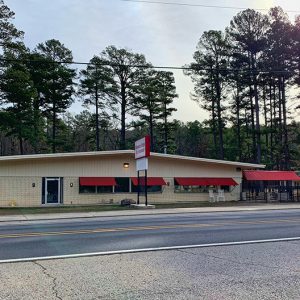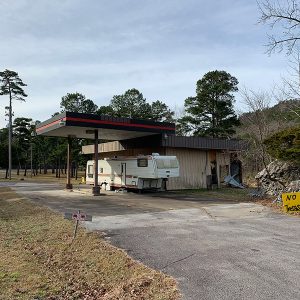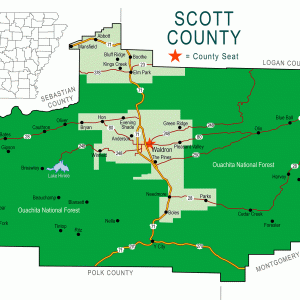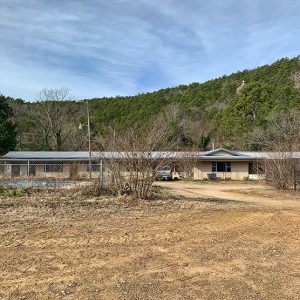calsfoundation@cals.org
Y City (Scott County)
Y City is an unincorporated community in southern Scott County located along Highway 71. Y City was established along Mill Creek, a tributary of the Fourche La Fave River. The community’s name is derived from the Y-shaped formation where Highway 270 splits off from Highway 71. Agriculture and tourism have been important to Y City’s economy and way of life.
Prior to European exploration, the area surrounding Y City was a wilderness. Several species of wildlife that no longer inhabit the area, such as elk and buffalo, were present throughout the region. Archaeological findings have provided evidence of early inhabitants dating to the Archaic, Woodland, and Mississippian periods. Further archaeological evidence has indicated that the people of the Caddo tribe later inhabited the area.
During the late seventeenth and early eighteenth centuries, French hunters and tradesmen traveled west from the Arkansas Post, exploring portions of western Arkansas. Several rivers that flow through Scott County were likely named by these French explorers, including the Petit Jean, Poteau, and Fourche La Fave rivers. It is probable that they traveled along the Fourche La Fave River near present-day Y City.
Settlers began arriving in Y City and the surrounding area during the late 1830s and early 1840s. The area was continually settled through the early twentieth century. Settlers participated in a wide variety of agricultural practices, including cotton farming.
Men called to fight in the Civil War served with both the Confederacy and Union. The women, children, and elderly were left to look after family homes and farms. Instances of bushwhacking occurred in the area during the Civil War.
After the Civil War, there were several main travel routes throughout the county. One of these routes went from Y City to the community of Dallas in Polk County. The route was known as Long’s Trail and, according to legend, was first made by an early explorer. In 1880, a post office with the name La Fave was established in Y City, with George C. Bradburn as the first and only postmaster. In 1882, the post office was discontinued.
In the early twentieth century, Y City contained only a grist mill for grinding corn and several small stores located at the junction of Highways 71 and 270. A gas station was later located just south of the junction.
During the 1920s, the first major road construction program for the county was started. In 1925, the Boardman Construction Company out of Oklahoma City established a camp near the Fourche La Fave River. The team began construction of the Fourche River Bridge and also surveyed a site for the Mill Creek Bridge in Y City.
Though there is no cemetery in Y City, residents have used the Chant (Scott County) cemetery for decades. Likewise, residents from Y City attended the Chant, Buck Knob (Scott County), and Boles (Scott County) school districts in the late nineteenth and early twentieth centuries. After 1953, when all of the school districts in the area had consolidated, students were sent to Waldron (Scott County) to attend school.
The town has served mostly as a stopping place for tourists and travelers, with Midway Park being the unofficial center of Y City. Over the years, the park was used as a wagon camp, tent camp, and eventually a tourist stop with small cabins. Some of Midway Park’s amenities included picnic tables, a go-cart track, and a swimming/fishing hole across the highway at Mill Creek. The park’s name comes from the fact that it is “midway” between Fayetteville (Washington County) and Texarkana (Miller County) on Highway 71. A restaurant was built at Midway circa the 1920s by W. Y. Vise, who also owned and operated the tourist cabins. Vise sold the restaurant and park to Bird and Francis Vines in 1955. The tourist cabins closed the same year. The original restaurant burned in 1963 and was rebuilt by the Vineses. The couple later opened a Phillips 66 gas station across the street from the restaurant. Midway Park was easily recognizable by the pine trees whose trunks had been painted white by Bird Vines to show that it was a recreation area. The Y City Mountain Inn Motel, located just north of the Mill Creek Bridge, was built in the early 1940s.
Bird Vines sold Midway Park in the early 2000s. The go-cart track had been unused for years. The Y City Mountain Inn was closed in the early 2000s and turned into a residence. The Phillips 66 station was closed prior to Midway being sold. The property came under new ownership and remodeling began on the restaurant with plans announced to reopen it. A single cabin is also available for rent at Midway.
In May 2013, a devastating flood struck Y City and the surrounding area, which resulted in the deaths of five people: Sherriff Cody Carpenter, Wildlife Officer Joel Campora, Vivian Sue Reimer and Regina Kay Shearn of Y City, and Cathy Ann Holder of Dallas (Polk County). The flood damaged numerous buildings, houses, and agricultural property in the area. It also altered portions of Mill Creek and the Fourche La Fave River, including the banks and the original water flow.
Hunting, fishing, and swimming are popular recreational activities in the area. Agriculture continues to be a prominent way of life, mostly in the form of cattle and chicken farms. Y City and the surrounding area are serviced by the Y City Volunteer Fire Department.
For additional information:
Cate, Michael. History of Scott County, Arkansas. Dallas, TX: Curtis Media Corporation, 1991.
Echoes: The Scott County Historical and Genealogical Society Quarterly. Waldron, AR: Scott County Historical and Genealogical Society (1986–).
Goodner, Charles. Scott County in Retrospect. Mansfield, AR: Frank Boyd, 1976.
Goodner, Norman. A History of Scott County, Arkansas. Siloam Springs, AR: Bar D Press, 1941.
McCutcheon, Henry Grady. History of Scott County, Arkansas. Little Rock: H. G. Pugh and Company, 1922.
Ty Richardson
Richardson Preservation Consulting








I found some duck carvings from mountain woodcrafters Y City, Arkansas, and I wondered if anybody might be interested in that.